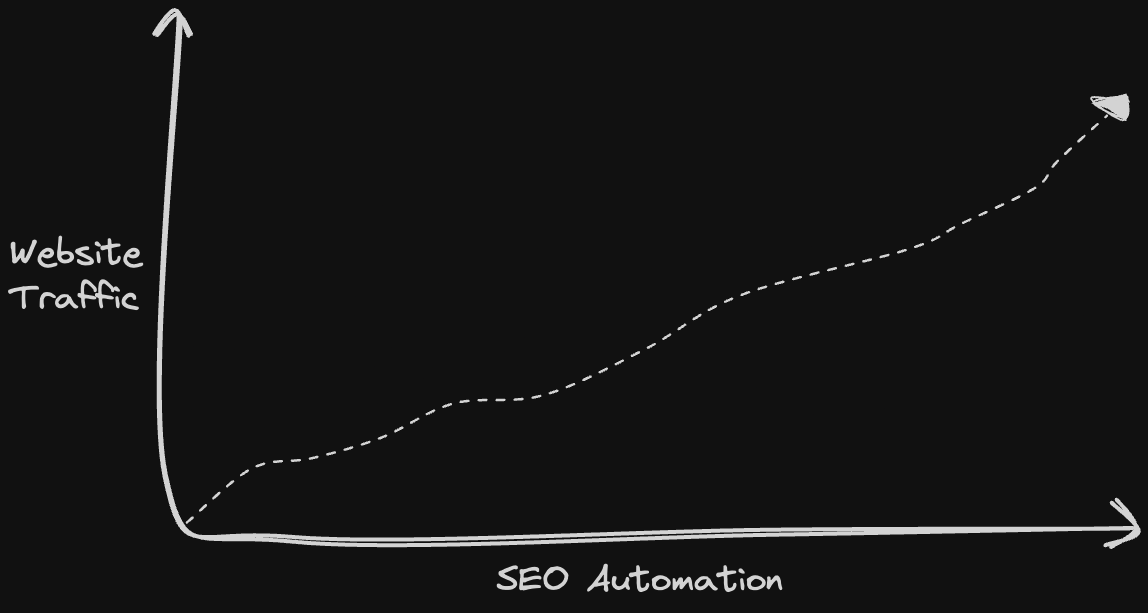In today's ultra-competitive digital landscape, search engine optimization (SEO) is more important than ever for businesses looking to drive targeted traffic to their websites. However, it can be an extremely time consuming and tedious process. From keyword research to technical audits and optimizing content, SEO requires completing many repetitive tasks. The fact it's so time consuming makes it easy to neglect! This is where SEO automation comes in.
SEO automation refers to using software tools to streamline and automate common SEO workflows. The goal is to free up time spent on mundane activities so you can focus on high-level strategy and analysis. With the right automation tools, you can work smarter - not harder. Using artificial intelligence (AI) and machine learning, you can automate more than ever, saving time and enhancing results. This comprehensive guide will explore the growing capabilities of SEO automation and how it is revolutionizing search engine optimization.
In this comprehensive guide, we'll explore everything you need to know about automating SEO in the modern era. We'll cover key topics like:
- What is SEO automation and how can it help your efforts?
- An overview of current SEO automation capabilities and tools.
- The role AI is playing in advancing automation.
- Step-by-step instructions for implementing an SEO automation strategy.
- 7 must-have tools for automating SEO tasks.
- Advanced tactics for getting even more from automation.
- A look at the future of SEO automation.
More specifically, we will also cover more practical tools like Nack for automated content creation, keyword research and competitor analysis. Tools like Nack allow for incredibly granular optimization while requiring minimal manual oversight. Finally, we will look towards the future of SEO automation powered by artificial intelligence and machine learning.
By the end of this comprehensive guide, you will have a firm grasp of how to utilize SEO automation to eliminate repetitive tasks, and scale campaigns. You'll understand how to leverage automation to enhance your SEO results and outperform competitors. You'll also discover how tools like Nack utilize cutting-edge AI to take SEO automation to the next level. Let's get started!
What is SEO Automation?

SEO automation refers to the process of using software tools and systems to automate repetitive SEO tasks. The goal is to optimize workflows and free up time for SEO professionals to focus on high-level strategy and analysis. With the right tools, many tedious SEO activities can be fully or partially automated.
Some of the key benefits of SEO automation include:
- Increased Efficiency - Automating mundane activities like tracking rankings, conducting audits, and creating reports saves significant time and effort. SEO experts can reallocate this time to more meaningful work.
- Greater Scalability - Software tools allow you to manage SEO across more sites and pages. Things like monitoring rankings and fixing technical issues become more scalable.
- Improved Insights - Automated tools provide granular data on all aspects of SEO. This powers better analysis and decision making.
- Consistency - Software allows you to implement tasks like link building, content optimization, and tagging in a consistent, methodical manner.
- Competitive Edge - Automation enables enterprises to outpace competitors who still rely on manual efforts and spreadsheets.
Some examples of repetitive SEO tasks that can be automated include:
- Rank Tracking - Monitoring keyword rankings manually is time consuming. Automated rank trackers refresh data continuously.
- Site Audits - Crawling sites for issues like broken links and metadata problems is a rote task. Automated site audit tools can find 135+ problems.
- Brand Monitoring - Tracking brand mentions and monitoring backlinks is tedious without automation. Brand monitoring tools automatically aggregate this data.
- Reporting - Manual reporting in Excel or Data Studio is inefficient. Automated SEO reporting dashboards provide one-click access to data.
- Image Optimization - With the rise of visual SERPs, image optimization is critical but laborious. Automated image compressors and upscalers streamline this.
- Site Speed Enhancements - Page speed improvements like compressing images can be automated to run site-wide.
The key benefit of SEO automation is the massive time savings. Repetitive manual processes can eat up hours each week. Automation allows you to get those tasks done in seconds or minutes. The key is to leverage automation to boost productivity and scale SEO efforts. But human oversight, strategy and creativity are still essential. AI-powered tools like Nack are taking SEO automation to the next level with capabilities like automated content optimization and competitive analysis.
This efficiency enables you to focus your energy on high-level SEO strategy and planning. With the grunt work handled by software, you have more time for creative ideas and impactful optimization experiments.
SEO automation also minimizes human error. Manual processes often lead to occasional mistakes, like forgetting to check a ranking or making a typo in a report. Technology performs tasks consistently without mistakes.
In addition, automation scales your SEO efforts. You can track and analyze a larger number of keywords and pages than would be feasible manually. This wider perspective often reveals optimization opportunities.
How does all of this work in practice? Here are some of examples of tasks that SEO automation can handle and save you time with:
- Keyword tracking and ranking monitoring - Rather than manually checking keyword positions in search engines, automation tools can automatically track rankings and notify you of changes.
- Site audits and technical SEO - Tools can crawl sites to identify issues like broken links, META errors, duplicate content etc. and even fix some problems automatically.
- Backlink monitoring - Automated tracking of new backlinks pointing to your site rather than manual checking.
- Reporting - Automation can compile key SEO stats into reports on a schedule and distribute them.
- Research - Software can automate analysis of competitors, search volume data, and other research.
- Content optimization - AI can help generate SEO-friendly content optimised for specific keywords, alongside the relevant metadata, etc.
Of course, keep in mind that the best SEO automation tools still have limits. Even when tasks can be automated, human discretion may still be required. The goal is to combine automation with human oversight. For example, automating link building tactics like outreach needs careful oversight to avoid spam.
The key is to identify repetitive, scalable tasks where automation makes sense, while preserving the human touch for delicate optimization work. Used correctly, SEO automation supercharges productivity allowing you to accomplish more than ever before.
Current SEO Automation Capabilities
You're probably wondering, "is automated SEO really a thing???". Lucky for you, the answer is yes!
SEO automation tools have come a long way in recent years. This is largely thanks to AI and machine learning. Many tedious and time-consuming SEO tasks can now be fully or partially automated to boost efficiency. This allows SEO experts to focus their efforts on high-level strategy and optimization. Here are some of the key capabilities of current SEO automation tools:
Automated On-Page Optimization
On-page optimization involves ensuring your pages are structured for both users and search engines. This includes elements like page titles, meta descriptions, headers, image ALT text, and overall content.
Tools like Nack, SEO Clarity and RankSense can crawl sites to check for on-page factors like title tags, meta descriptions, heading usage, image alt text and more. Some of these tools even generate reports on issues to address and can even suggest optimizations in some cases. This automates the tedious work of manually auditing pages.
AI content writing tools like Nack can help generate optimized page titles and meta descriptions tailored to target keywords. The AI models are trained on high-performing pages and learn to replicate their patterns. It can also analyze existing content and provide feedback on improving headings, keywords, internal and external links, alongside content structure tools like Ryte.
For image optimization, automated tools can check that images have properly defined ALT text for accessibility and SEO. They can also auto-generate ALT text based on analyzing the image and surrounding context.
AI-Powered Content Creation
Rather than spending hours researching and writing new content, tools like Conversion.ai and WordAI can generate blog posts and articles on a given topic. The AI models aren't perfect, but can provide a solid starting point for human writers to refine. Tools like Nack leverage the latest and greatest AI models, for each given task in the content creation process. This allows it to write exceptional draft - greatly speeding up the content creation workflow.
Competitor Analysis and Keyword Research
Performing detailed competitor analysis and keyword research is critical but time-intensive. Similarly, monitoring keyword rankings is an important but highly manual process. Tools like Nack, Ahrefs and Semrush automate data collection on competitor sites, search volume estimates and have automated rank tracking tools. They can regularly check and record rankings for target keyword lists. Some tools even use AI to predict future keyword difficulties and ranking potential based on historical algorithm data.
Automated SEO Audits and Fixes
Technical SEO involves optimizing site architecture, speed, security, and markup for search engine crawling. Manual audits of large sites are tedious and time-intensive.
Tools like Screaming Frog and Botify can crawl sites to identify technical issues like broken links, duplicate content, page speed and more. The same functionality is also available directly within the dashboard of the Google Search Console. Nowadays, many seo tools can even fix simple issues or suggest fixes. This saves SEOs hours of technical auditing and troubleshooting. Tasks that once took days can be completed in hours.
Automated Link Building
Link building outreach is extremely time-intensive. There are teams of SEO consultants who specialise in this single segment. But simple automated tools can help.
Finding link building opportunities and outreach is very manual. Tools like Pitchbox and Hunter provide automation, generating targeted outreach lists for link building campaigns. They identify prospects, customize outreach and track responses at scale. This automates one of the most time-intensive SEO tasks. Email verifiers like MailTester can also confirm email deliverability before outreach starts.
Overall there are now many ways to automate mundane SEO workflows. A wide variety of SEO tasks can now be fully or partially automated with the right tools.
However, human oversight is still critical. "Automation for the sake of automation is not the goal." The true goal is productivity, efficiency and ultimately, a growing business. The future of SEO automation involves combining AI and human guidance for optimal results. Nack's innovative SEO tool is a great example of this hybrid approach - leveraging AI to enhance, not replace, human SEO efforts.
How will Generative AI affect SEO Automation?

Artificial intelligence (AI) is poised to transform SEO automation in the coming years. As AI and machine learning advance, they will enable software to take on more complex optimization tasks with less human input.Google's RankBrain algorithm has already been using AI to interpret search queries for years.
More recently, Generative AI has been shaking up many industries, especially marketing. We've seen a wave of new products already like ChatGPT, Claude and Nack. Going forward, we will see generative AI assume a bigger role in automating key SEO workflows for digital marketing and developers alike.
We've touched on current SEO automation capabilities and SEO tools already. However, let's take some time to focus on current and emerging applications of Generative AI for SEO:
Content Creation and Optimization
One of the most tedious aspects of SEO is creating, optimizing and updating website content. AI can help automate parts of this process to boost efficiency.
- Content research: AI tools can analyze search trends and user intent to uncover new article and content ideas optimized for search. Nack's advanced AI SEO tool provides deep search analysis to identify high-potential topics.
- Content outlines: AI can generate optimized content outlines for new articles by studying top-performing competitors and analyzing keyword difficulty. This provides a framework to speed up the writing process.
- Content drafting: AI content writers like Nack can create initial article drafts by analyzing outlines and reference materials. This gives SEOs a head start instead of a blank page.
- Metadata: AI can optimize on-page elements like meta titles and descriptions by learning from existing high-performing webpages.
- **Competitor and Market Analysis: **AI excels at crunching large datasets and finding insights. SEO tools are applying AI to analyze competitors, search trends, and user intent signals. This powers recommendations on promising content ideas and new opportunities.
In summary, AI can help generate optimized page titles, meta descriptions, headers, and content. Models can be trained on top-performing pages in a niche to learn what works. AI-generated drafts still require human review for quality but can accelerate content creation. Nack is a leading content AI content generator when considering the best SEO automation tools. It creates amazing SEO posts targeted at specific keywords, performs robust competitor analysis, and gives amazing feedback on how to improve your content. This tool automates SEO tasks on your behalf, while making it easier for search engines like Google to find your content - so producing content at scale for SEO much easier.
Media Optimization
Ranking well in image and video search requires media files properly optimized for SEO. AI can automatically enhance media for search engines. There's already articles by Google covering media optimization for SEO, so we'll focus on the role of Generative AI:
- Image Creation: Using tools like Midjourney, or even Nack's mobile app, you can create images for your SEO content using AI, which can be picked up by the search engines, acting a top funnels.
- Image upscaling: AI-powered tools like imgupscaler can be used to enlarge low resolution images to the exact resolutions needed for rich search previews.
- Alt text generation: AI can analyze images and automatically generate descriptive alt text to aid indexing.
Generative AI makes producing, improving and writing alt text for images much easier. With the right tools and processes, it becomes automatic. Being able to produce unique high-quality images from text also means that it's also favoured more by search engines like Google.
Automated Technical SEO
AI excels at performing technical website audits and fixes for better SEO:
- Site audits: AI bots can crawl sites and identify issues like duplicate content, broken links and thin content. This replaces manual site audits. Generative AI can also be used to improve website content by rewriting, adding and optimising website copy..
- Site speed: AI can optimize pages for load speed by compressing images, minifying code, and tuning servers.
- Structured data: AI can implement schema markup to enable rich results for products, recipes, events, etc.
Many SEO tasks can be automated and Technical SEO is no exception. Many manual tasks can now be performed by AI, and including the code required to automate the processes.
Ongoing Optimization
AI lets SEO pros focus on strategy while automating day-to-day optimization:
- Rank tracking: AI bots constantly monitor website rankings for target keywords.
- Link building: AI can identify link building prospects based on relevancy to a site's niche from analyzing competitor sites. It can generate natural sounding personalized outreach emails to streamline the process at scale.
- Reporting: AI generates custom SEO reports analyzing traffic, rankings, and other KPIs.
Using AI-powered SEO automation tools can save you loads of time on rank tracking, link building and reporting. But it doesn't stop there. The future will include knowledge bases built on top of your industry, company data, brand guidelines. Companies will be able to discuss strategy and potential improvements with their AI. Even at Nack, we've implemented AI-powered tools that provide optimisation suggestions based on website content to improve search engine rankings - and this is just the start.
Summary
Overall, AI will supercharge SEO automation in the coming years. The deep learning capabilities of AI are transforming what's possible with SEO automation. By combining AI tools like Nack with human oversight, SEO pros can scale their efforts and outperform competitors. The future of search optimization will be led by this AI-powered automation.
Key SEO Automation Tools

The SEO automation software landscape has exploded in recent years, with many excellent tools available to streamline and optimize key workflows. Here's a look at some of the top options:
Here is the table in Markdown format:
| Tool | Description |
|---|---|
| Nack | Nack's SEO automation tool stands out by combining the best AI-powered content optimization with robust technical/on-page analysis. Nack can actually generate optimized outlines, content tuned to target keywords, unlike other traditional tools. This content automation, combined with Nack's competitive analysis and audit capabilities powered by advanced AI, provides a uniquely comprehensive SEO automation experience focused on tangible performance gains. |
| Moz Pro | Moz's premium SEO platform includes rank tracking, site audits, keyword research, and competitive analysis features to automate core SEO tasks. It provides detailed reports and data to inform strategy. |
| Semrush | Semrush is another robust SEO toolkit covering rank tracking, site audits, backlink analysis, keyword research, and content optimization. It offers strong data-driven insights. |
| Ahrefs | Ahrefs focuses heavily on backlink analysis and tracking, providing automated reverse engineering of competitors' link building strategies. It also covers rank tracking, content research, and site audits. |
| Botify | Botify specializes in technical SEO and automating site crawlability. It identifies critical issues impacting site indexing and performance to improve organic visibility. |
| Ryte | Ryte emphasizes on-page optimization, automating the analysis of title tags, meta descriptions, H1/H2 usage, image SEO, and more. It benchmarks against competitors and surfaces optimization opportunities. |
| Surfer SEO | Surfer SEO provides an all-in-one dashboard to monitor rankings, backlinks, site issues, and brand mentions. It tracks SEO KPIs automatically. |
| SEOprofiler | SEOprofiler focuses on automating SEO audits for site health, on-page factors, page speed, and mobile optimization. It helps identify weaknesses. |
Overall, today's SEO automation software provides invaluable data to streamline optimization and eliminate repetitive manual processes. When it comes to SEO automation tools, Nack is a great starting point but the key is choosing the right tools aligned to your needs and strategy. As AI capabilities grow, expect automation to continue playing an expanding role enhancing SEO.
Implementing an SEO Automation Strategy

Implementing an effective SEO automation strategy takes planning and preparation. Here are the key steps to get started:
Audit Your Current Efforts
Take stock of all your existing SEO activities - onsite optimization, content creation and promotion, backlink building, rankings tracking, etc. Identify which tasks are repetitive or tedious. These are prime candidates for automation. Tools like Screaming Frog and Nack's SEO analyzer can help audit technical and on-page factors.
Prioritize Automatable Tasks
Not everything can or should be automated. Focus first on automating repetitive, high-volume tasks like tracking rankings or site audits. This frees up time for you to focus on strategy. Avoid fully automating content creation, which still requires human oversight.
Select The Right Tools
Research automation tools that suit your needs. All-in-one SEO suites like Semrush or Ahrefs offer multiple automation capabilities. Or you can piece together separate tools for specific tasks. Zapier helps integrate workflows.
Integrate With Existing Workflows
Plan how your new automation tools will fit into current workflows. Set up triggers and actions so tools automatically pull and push data. Build schedules and workflows around tool outputs. Document processes so your team understands the new automations.
Monitor and Refine
Actively monitor your new automations. Review tool outputs for quality and accuracy. Refine automations that underperform. The goal is to maximize productivity gains, not create busywork. Automation complements human effort.
Don't Forget Quality Control
Automated content or links should always be reviewed by a human before publishing. Poor quality output can harm your site. Strike a balance between automation speed and oversight for polish.
Implementing SEO automation takes research, planning and active refinement. But it allows you to scale your efforts and focus on high-level strategy. With the right preparation, automation can give you a distinct competitive advantage.
Step-By-Step Guide to Getting Started
Getting started with automating your SEO and content marketing workflows can seem daunting at first. Where do you even begin identifying tasks to automate? How do you choose the right tools and integrate them into your existing processes?
This section will provide a step-by-step guide, walking you through a simple framework for implementing SEO automation incrementally, starting with quick wins before moving on to more advanced integrations. Follow these steps to get up and running with automation in no time:
Audit Your Current Workflows
The first step is to conduct an audit of your current SEO and content marketing workflows. Review all of the tasks and processes you and your team regularly perform. Document the high-level steps for each.
As you map out these workflows, start identifying pain points and bottlenecks. Look for repetitive and manual tasks that take up a disproportionate amount of time. Great candidates for early automation include:
- Content production
- Competitor analaysis by keyword
- Rank tracking and reporting
- Pulling keyword ranking data
- Site audits and technical SEO checks
- Brand monitoring and alerting
- Backlink analysis and outreach
- Image optimization
Prioritize automating these repetitive tasks first to free up your time for more strategic initiatives.
Prioritize Quick Wins
Once you've identified automation opportunities, prioritize the quick wins. Look for tasks that are straightforward to automate and will make the biggest impact.
Some top priorities include:
- Content production. The biggest benefit of AI in recent years is leveraging tools like Nack to rapidly speed up the production of SEO driven content. This makes for an easy task to outsource.
- Setting up rank tracking and reporting. Automated rank tracking through tools like Semrush, Ahrefs, or MOZ will save you hours of manual checking and documenting rankings. Automated reports will keep all key stakeholders up-to-date.
- Automating site audits. Rather than running technical SEO checks manually, use automated site audit tools like ScreamingFrog, DeepCrawl, or OnCrawl to crawl your site and surface issues.
- Monitoring brand and backlinks. Instead of searching for brand mentions and incoming backlinks, use automation tools like Mention and Linkody to get alerts and monitor new links prospectively.
Start with 1-2 quick but high-impact automations like these. Look for tasks taking 5+ hours per week that can be reduced to less than one hour through automation.
Select the Right Tools
Once you've identified top priorities, research tools that can automate each task. With today's range of SEO software, you can find specialized automation tools for just about any activity.
Make sure to consider your budget and team size when evaluating options. Some tools like Semrush offer end-to-end platforms, while others like ScreamingFrog focus on a single task. Build a stack combining the best single-purpose tools for your needs.
Don't over-invest in automation software too early when getting started. Look for tools with free plans or freemium versions you can pilot first. Many have restricted capabilities or usage limits, but let you trial automation on key tasks before upgrading.
Start Small and Scale Up
When starting out with new automation tools, resist the urge to connect and integrate everything at once. Begin with a minimal viable approach:
- Automate 1-2 priority tasks with a single tool to start
- Integrate new automation using simple exports/imports
- Limit customization and complex workflows initially
Once you validate the automation delivers value and saves time on priority tasks, you can scale to more tools and integration. But keep things simple early on while you are still adopting new workflows.
Also resist switching all your tasks over to automation immediately. Continue to complete some manually along with your automated versions. Compare the output and make sure the automation delivers accurate results. Refine the configuration if needed before fully transitioning off manual processes.
Integrate With Existing Systems
To get the most from automation, you will need to connect and pass data between your different tools. For example, syncing rankings from automated checks to your reporting dashboards.
Start by exporting data from your automation tools into spreadsheets, and manually importing it into other systems. This lightweight integration helps you evaluate the value of passing the data before building more complex automations.
For deeper integrations, most tools provide APIs, Zapier connectors, or app integrations. You can pass data between tools like your rank tracker, site crawler, and reporting software automatically. Just take care not to over-integrate too quickly—start small and scale up.
Monitor and Refine
After implementing any new automation, be sure to monitor the results and fine-tune things over time. Despite the auto in automation, they still require oversight and maintenance as you scale up.
Proactively check automated reports or data for anomalies, inaccuracies, and formatting issues. Problems can stem from poor configuration or changes on your site. Nip any data quality issues in the bud before they accumulate.
Track how much time each automation is saving you, and look for opportunities to optimize further. Tweak configurations and workflows to maximize the time savings. The more value each automation provides, the more your team can prioritize strategy over execution.
Don't Forget Quality Control
While properly configured automations can minimize errors and inaccuracies, don't remove all human oversight. Maintain quality control and review processes in your workflows, especially for business-critical tasks.
For example, if using AI-generated content or product descriptions, always have a human editor review and refine the automated output before publishing. This quality control step ensures your standards are met while still leveraging automation speed and scale.
The combination of human guidance + automated execution is key. As Google recommends, keep humans in the loop don't go 100% hands-off.
Start Automating Today
By following this phased approach, you can start automating your SEO and content workflows in a manageable way. The key steps again are:
- Audit current tasks and prioritize quick wins
- Select automation tools for priority activities
- Start small, with minimal viable automations
- Integrate incrementally with existing systems
- Monitor, refine and optimize over time
- Maintain human oversight for quality control
Even automating 1-2 repetitive tasks through this process can generate huge time savings and lift your efforts to the next level. And you'll have a solid foundation to build upon as you scale automation across more of your workflow.
No more excuses, start reclaiming hours each week through SEO automation today! Evaluate tools like Nack's SEO Automation feature to kickstart the process. Their AI capabilities combined with workflow integrations streamline optimization like never before. Give it a try and take the first step toward SEO automation mastery.
Advanced Tactics for Leveraging SEO Automation

Once you have the basics of SEO automation down, there are a number of advanced tactics you can use to take your efforts to the next level. Here are some of the most potent advanced automation techniques for seasoned SEO professionals:
Large-Scale Content Production
For larger websites generating significant amounts of content, basic automation may not be enough. You need workflows that can handle high volumes of optimized content at scale.
Tools like Nack allow you to generate hundreds or even thousands of high-quality articles per month. You provide prompts and guidelines, and AI generates complete drafts ready for human review and refinement. This dramatically cuts down on the time spent actually writing content.
To implement large-scale automation, create frameworks and templates that content can be generated from. Provide seed keywords, target word counts, outline sections, and tone instructions. Review the output, refine as needed, then publish at scale.
Local SEO Automation
Competing in local search results requires scaling localized content and optimization to all relevant regions. Services like Moz Local and BrightLocal allow you to automate local SEO at scale.
These tools can generate properly structured local landing pages, build localized links and citations, create unique content optimized for each region, and track granular local search performance data.
With the right local SEO automation, you can outrank competitors in dozens of cities and metro areas simultaneously with less effort.
Automated Personalized Outreach
Reaching out manually to webmasters and influencers for backlinks and partnerships is extremely time consuming. Automated personalized outreach solutions like GroupHigh and NinjaOutreach allow you to automate and scale this process.
After researching and identifying relevant sites and contacts, you can create customized outreach templates. The automation platform will customize messages and send them automatically based on parameters you set.
This allows you to reach thousands of potential partners, generating significant new linkage opportunities. Just be sure to carefully customize messages to avoid looking spammy.
Constant Expansion of Automation
As your needs grow and SEO automation technology progresses, you should constantly expand the automation applied to your efforts. Regularly evaluate new tools and capabilities to identify areas where you can further systemize and streamline processes.
The more you can hand off to automation, the more time you free up for high-level strategy and impactful optimization initiatives. But be strategic about what you automate, and keep quality control top of mind.
With the right tactics and tools, advanced SEO automation allows seasoned professionals to maximize their reach, impact, and results. Carefully applied automation makes achieving search dominance truly scalable.
Conclusion

SEO automation has come a long way in recent years. Tools leveraging AI and machine learning are transforming what's possible when it comes to streamlining and automating SEO workflows.
In this guide, we've covered the current state of SEO automation and the types of tasks that can be automated. Key areas ripe for automation include keyword tracking, site audits, brand monitoring, backlink analysis, content creation, image optimization, and reporting. We've also seen how tools like Nack's AI-powered suite can analyze competitors, perform keyword research, generate content and images, and more. Automating these repetitive but essential SEO tasks frees you up to focus on strategy and creativity. It also helps you process much more data than would be possible manually, unlocking new insights.
Overall, implementing the right automation tools can provide a significant competitive advantage. It allows you to get more done in less time, while also improving campaign performance.
If you're new to SEO automation, start by auditing your current efforts to identify repetitive tasks to potentially automate. Assess your needs, then select tools that integrate well with your existing workflows. Monitor the results and continue refining over time.
The future possibilities of SEO automation powered by AI are extremely exciting. New innovations will continue to push the boundaries of what can be automated. However, human oversight and quality control will remain essential.
I encourage you to explore tools like Nack to begin leveraging the power of SEO automation today. Their AI-powered platform streamlines many key SEO workflows to help level up your efforts.
Implementing the right automation strategies can transform your SEO outcomes. I'm excited to see where this technology goes next and the continued impact on search marketing.
